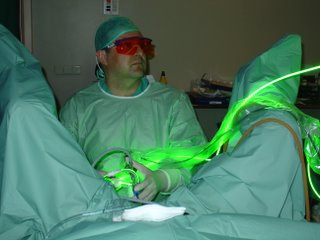 Today I took a flight to Barcelona to participate in a training session on PVP - Photoselective vaporization of the prostate. We had programmed two patients, the first case was straightforward, the second was very complex. The second patient in the list had morbid obesity and respiratory problems, and we planned to operate him in the sitting position, to increase the chances for him to tolerate the operation. His prostate was relatively big, weighing 100 g. The first case was uneventful, the second case was cancelled because the patient did not respect the "nil per mouth" instruction and he had had breakfast consisting in coffee and cookies. The anaesthesiologist thought we could not operate him with a full stomach, so we have rescheduled him for another date and I went back to Madrid.
Today I took a flight to Barcelona to participate in a training session on PVP - Photoselective vaporization of the prostate. We had programmed two patients, the first case was straightforward, the second was very complex. The second patient in the list had morbid obesity and respiratory problems, and we planned to operate him in the sitting position, to increase the chances for him to tolerate the operation. His prostate was relatively big, weighing 100 g. The first case was uneventful, the second case was cancelled because the patient did not respect the "nil per mouth" instruction and he had had breakfast consisting in coffee and cookies. The anaesthesiologist thought we could not operate him with a full stomach, so we have rescheduled him for another date and I went back to Madrid.
As this blog entry is not very exciting, I will use the oportunity to show the kind of effect PVP has on flow rates. Below I show how a flow rate measurement looks like, this test measures urinary flow (volume of urine passed in mL per unit of time in seconds) and represents it on a graph. For the patient, a flowmetry consists in passing water into a funnel connected to the registry equipment, so it is a painless test. It gives very useful information.
Here I show the preop and postop flowmetry of a patient. Initially the flow was very low and bladder emptying was incomplete. After PVP, the flow improved more than threefold. The patient was able to empty his bladder completely and very quickly after the operation.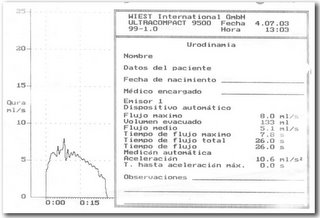

Wednesday, January 25, 2006
New (half-)training session in Barcelona
Published by
Fernando Gómez Sancha
on
8:34 PM
0
comments
![]()
Saturday, January 14, 2006
New training session in Valencia
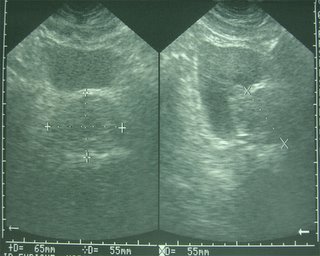 Today, a saturday, I took an early plane to Valencia in order to participate in a training session on KTP laser for the treatment of Benign Prostatic Hyperplasia. I operated a high risk patient with a 100 gram prostate. The operation was uneventful and I hope the patient will go home later today.
Today, a saturday, I took an early plane to Valencia in order to participate in a training session on KTP laser for the treatment of Benign Prostatic Hyperplasia. I operated a high risk patient with a 100 gram prostate. The operation was uneventful and I hope the patient will go home later today.
This patient had a very big median lobe, that can easily be seen in this ultrasound image. The way I treat median lobes is to reduce them uniformly until I reach the bladder neck, and then I perform an incission in the midline until I see the bladder neck fibres. Later on, the bladder neck is widened laterally. This strategy avoids damaging the ureteral orifices. It is a simple and quick way of treating the median lobe and achieving a fantastic result without risk of complications. This christmas I could not sleep one night and I started drawing these in order to explain this technique to other doctors interested in KTP laser prostate surgery (PVP- Photoselective Vaporization of the Prostate).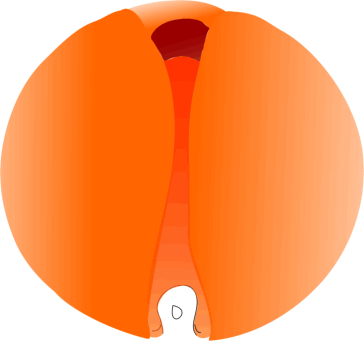
Interestingly, one of the surgeons attending the surgical session in theatre has asked me to fly to Valencia again in March in order to operate him, he is very bothered by his symptoms and he has decided to undergo PVP. It will be my pleasure to treat a colleague.
Published by
Fernando Gómez Sancha
on
8:54 PM
1 comments
![]()
Laser Surgery for Urinary Stones
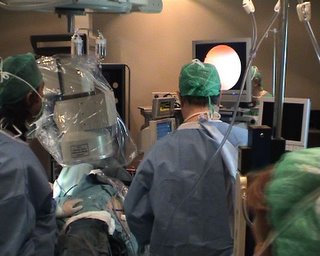 Today we have used for the first time our new Holmium laser, Stonelight, manufactured by Laserscope.
Today we have used for the first time our new Holmium laser, Stonelight, manufactured by Laserscope.
We invited Dr. Gaspar Ibarluzea in this ocassion as invited surgeon. He is a fantastic endourologist from Bilbao. Dr. Luis Llanes, the director of the stone unit from the Institute of Advanced Urological Surgery and I helped him to treat two patients with very complex urinary stones.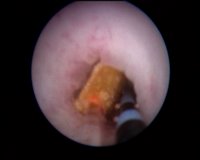
Endourology has advanced significantly with the use of Holmium laser. It fragments stones easily respecting the tissues from the urinary tract and allows us to treat urinary stones endoscopically, in a minimally invasive way. Patients recover very soon and go back to their normal life in a few hours in the simpler cases or in a few days in the more complex ones. Today, endourology is taking over extracorporal shock wave lithotripsy because is more efficacious and quicker for the patient.
We operated two patients, and we had the chance to check the efficacy of this Stonelight laser in kidney and ureteral stones. We first performed a percutaneous surgery on a very big uric acid stone that filled the whole left renal pelvis and the upper part of the kidney, and then we performed a left flexible ureteroscopy and intracorporeal holmium laser lithotripsy followed by a right percutaneous surgery in the same patient.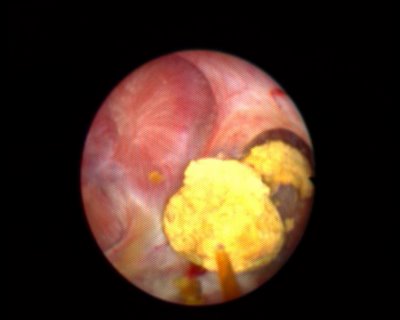
A fantastic day, we learned a lot. My colleague from the ICUA, Dr. Luis Llanes, has plenty of experience with these endourological techniques and from now on we will be able to offer the newest endourological treatment options with Holmium laser to our patients.
Published by
Fernando Gómez Sancha
on
8:11 PM
0
comments
![]()
Monday, January 09, 2006
Laparoscopic Radical Prostatectomy with Dr. Gastón
This saturday we had the privilege of inviting Dr. Gastón to operate with us a patient with a localised prostate cancer. Dr. Gastón is well known for having developed the technique of laparoscopic radical prostatectomy for prostate cancer and is considered the world leader in this technique. He has operated more than 3000 patients. As an example of his immense experience, he performs two or three laparoscopic radical prostatectomies per day in his hospital in Bordeaux, France.
After picking him up at the airport in Madrid, Dr. Gastón, Dr. Ignacio Castillón and I went to our Hospital USP San José, where we performed the operation that was uneventful. We were deeply impressed by the perfect technique and the anatomic knowledge of Dr. Gastón, who needed two hours to complete the operation with a minimal blood loss (less than 30 cc of blood). The patient was discharged on monday morning.
Dr. Gastón mentioned that this technique allows obtaining a high quality urinary continence postoperatively and that the chances of preserving sexual function is very high, specially in younger patients. Our institution, the Institute of Advanced Urological Surgery, has reached an agreement with Dr. Gastón to bring him over to Madrid to operate our patients so they can have access to a world leader in prostate cancer surgery without having to leave their country.
Our institution, the Institute of Advanced Urological Surgery, has reached an agreement with Dr. Gastón to bring him over to Madrid to operate our patients so they can have access to a world leader in prostate cancer surgery without having to leave their country.
Published by
Fernando Gómez Sancha
on
7:36 PM
0
comments
![]()





